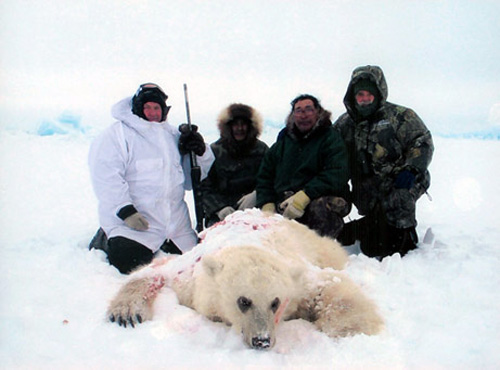
Hybrid grizzly-polar bear a curiosityBy NED ROZELL
April 08, 2013
“He had two polar bear rugs in his house - one was a huge one, and the other was special; it had lots of brown in it,” Seaton said. “It looked like a regular polar bear, but for every square inch of hide, 5 to 20 percent of the hairs were brown instead of white.”
American hunter Jim Martell, left, is seen with a hybrid bear he shot while on a hunting expedition on Banks Island, Northwest Territory, Canada, in April 2006. Genetic tests showed the bear had a polar bear for a mother and a grizzly bear for a father. Roger Kuptana, center, right, was the guide on the expedition. The other men are unidentified. (Photo courtesy Canadian Wildlife Service).
That combination of large bears is so rare that DNA testing of the hybrid bear shot in 2006 off Banks Island in Canada’s high Arctic proved for the first time that a wild bear had a polar bear as its mother and a grizzly as its father. An Associated Press reporter wrote that the bear had brown patches on its white coat, long claws, and the humped back of a grizzly. Biologists say the merger is unlikely because the two species don’t interact very much - barren-ground grizzlies of the Arctic hibernate during much of the time polar bears have access to land. Polar bears are often far out on the sea ice when they’re ready to breed, but people sometimes see them on land in summer, as was the case in 1990 when oil exploration workers saw a polar bear 50 miles inland from the Beaufort Sea coast. University of Alaska Fairbanks scientists doing genetic testing about a decade ago found that grizzly bears may be the ancestral fathers of polar bears, which over many thousands of years perhaps evolved to life on sea ice by developing all-white coats, furry feet, and teeth designed to rip seal flesh. People sometimes see the two bears together at whale carcasses, such as at a bowhead whale boneyard outside Kaktovik, where in fall both polar and grizzly bears feast on the remains of whales harvested by villagers. Those who have seen the bears there say that the grizzlies, often smaller than the polar bears, dominate the encounter. “They are two very different animals as far as behavior goes,” said Geoff York, a polar bear researcher at the USGS Science Center in Anchorage. “When a brown bear comes in at the bone pile, it chases off all the polar bears.” Dick Shideler, a biologist at the Alaska Department of Fish and Game in Fairbanks who at the time studied the farthest-north grizzly, had documented grizzly bears on the sea ice north off Alaska’s coast. “We’ve radio collared a grizzly bear who hunts seals in the spring,” Shideler said. “Our pilot has tracked him on the ice, going from hole to hole. He’s figured it out.” Shideler also said biologists from the Northwest Territories have in the past shared reports of what could have been hybrid bears. “There was a grizzly up there towards Banks Island that killed a bunch of seals, and (a pilot) tracked it and saw its tracks intersecting with those of a polar bear,” he said. The carpet of tracks on the snow looked like the bears could have mated, Shideler said. “The next year a helicopter pilot saw a female with darker cubs,” he said. “And (hybrids) have been reported quite a few times by Natives (of Canada’s Arctic).” Biologists don’t think “grolar bears” could outcompete either species; a hybrid probably wouldn’t forage on land as well as a grizzly bear, and a mottled brown coat wouldn’t be the best camouflage on sea ice. Related:
Since the late 1970s, the University of Alaska Fairbanks' Geophysical Institute has provided this column free in cooperation with the UAF research community.
E-mail your news &
photos to editor@sitnews.us
|
||
